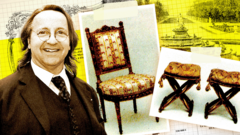In the early 2010s, the French antiques market was rocked by the discovery of two ornate chairs, allegedly linked to the Palace of Versailles. Believed to be the most extravagant creations for Marie Antoinette, the last queen of France, these stunning pieces bore the seal of the esteemed cabinetmaker Nicolas-Quinibert Foliot, known for his work in the 1700s. Named "national treasures" by the French government at Versailles' behest in 2013, the chairs caused a stir when they were sold to Qatari Prince Mohammed bin Hamad Al Thani for a staggering €2 million (£1.67 million) after Versailles deemed the asking price too high.
In recent years, a surge of 18th-century royal furniture has surfaced in the antiques market. Items ranging from chairs presumed to have graced Marie Antoinette's chambers to furniture owned by other notable figures of the French court emerged. Many were acquired by Versailles for its museum collection, sparking interest from affluent buyers.
However, as these luxurious items made headlines, a shocking revelation emerged: many, if not all, of these royal chairs were counterfeits. The scandal implicated leading antiques expert Georges "Bill" Pallot and renowned cabinetmaker Bruno Desnoues, as they faced trial for fraud and money laundering following an exhaustive nine-year investigation. Galerie Kraemer and its director, Laurent Kraemer, were also charged with gross negligence in the sale of the chairs, which they adamantly denied.
The two men admitted to their roles, stating that their fraudulent enterprise began in 2007 as a playful experiment to replicate a chair from Madame du Barry. Pallot, an acclaimed scholar on 18th-century chairs, leveraged his expertise and connections to acquire cheap wood frames, while Desnoues crafted replicas that expertly mimicked historical designs.
Despite their successes, their actions ultimately led to an estimated €3 million profit from the forged chairs. Their elaborate deception unravelled when authorities connected lavish spending by a handyman to the scheme, prompting an investigation into the shady dealings surrounding the antiques market.
As the trial progressed, charges against some initially implicated were dropped, but the case against Laurent Kraemer and his gallery continued. Prosecutors maintained that the gallery was "grossly negligent" for not sufficiently validating the authenticity of the high-priced furniture. Defense lawyers argued their client was merely a victim of the fraud.
The unfolding horror of this scandal not only damaged the reputations of respected figures in the antiques world but also reflected the urgent need for stricter regulations and a reconsideration of due diligence among dealers. In the end, this case serves as a stark reminder of how expertise can be exploited to mask deceit in the world of art and antiques.
In recent years, a surge of 18th-century royal furniture has surfaced in the antiques market. Items ranging from chairs presumed to have graced Marie Antoinette's chambers to furniture owned by other notable figures of the French court emerged. Many were acquired by Versailles for its museum collection, sparking interest from affluent buyers.
However, as these luxurious items made headlines, a shocking revelation emerged: many, if not all, of these royal chairs were counterfeits. The scandal implicated leading antiques expert Georges "Bill" Pallot and renowned cabinetmaker Bruno Desnoues, as they faced trial for fraud and money laundering following an exhaustive nine-year investigation. Galerie Kraemer and its director, Laurent Kraemer, were also charged with gross negligence in the sale of the chairs, which they adamantly denied.
The two men admitted to their roles, stating that their fraudulent enterprise began in 2007 as a playful experiment to replicate a chair from Madame du Barry. Pallot, an acclaimed scholar on 18th-century chairs, leveraged his expertise and connections to acquire cheap wood frames, while Desnoues crafted replicas that expertly mimicked historical designs.
Despite their successes, their actions ultimately led to an estimated €3 million profit from the forged chairs. Their elaborate deception unravelled when authorities connected lavish spending by a handyman to the scheme, prompting an investigation into the shady dealings surrounding the antiques market.
As the trial progressed, charges against some initially implicated were dropped, but the case against Laurent Kraemer and his gallery continued. Prosecutors maintained that the gallery was "grossly negligent" for not sufficiently validating the authenticity of the high-priced furniture. Defense lawyers argued their client was merely a victim of the fraud.
The unfolding horror of this scandal not only damaged the reputations of respected figures in the antiques world but also reflected the urgent need for stricter regulations and a reconsideration of due diligence among dealers. In the end, this case serves as a stark reminder of how expertise can be exploited to mask deceit in the world of art and antiques.




















